Healthcare Management and Leadership: NHS Foundation Trust Report
VerifiedAdded on 2023/01/04
|13
|3919
|54
Report
AI Summary
This report delves into the complexities of the healthcare environment, using the NHS Foundation Trust as a case study. It begins by defining the healthcare environment and its critical aspects, such as patient safety and infection control. The report then explores the multifaceted roles of a healthcare manager within this setting, including change management, legal compliance, personnel management, record-keeping, and financial oversight. The second scenario analyzes how organizational structure influences company culture, referencing Handy's model of organizational culture (power, role, task, and person cultures) and providing a case study of a merger between a hierarchical GP surgery and a flat-structured social enterprise. The report concludes by discussing different organizational structures available within health and social care provisions. Overall, the report provides a comprehensive understanding of healthcare management, leadership, and organizational dynamics.
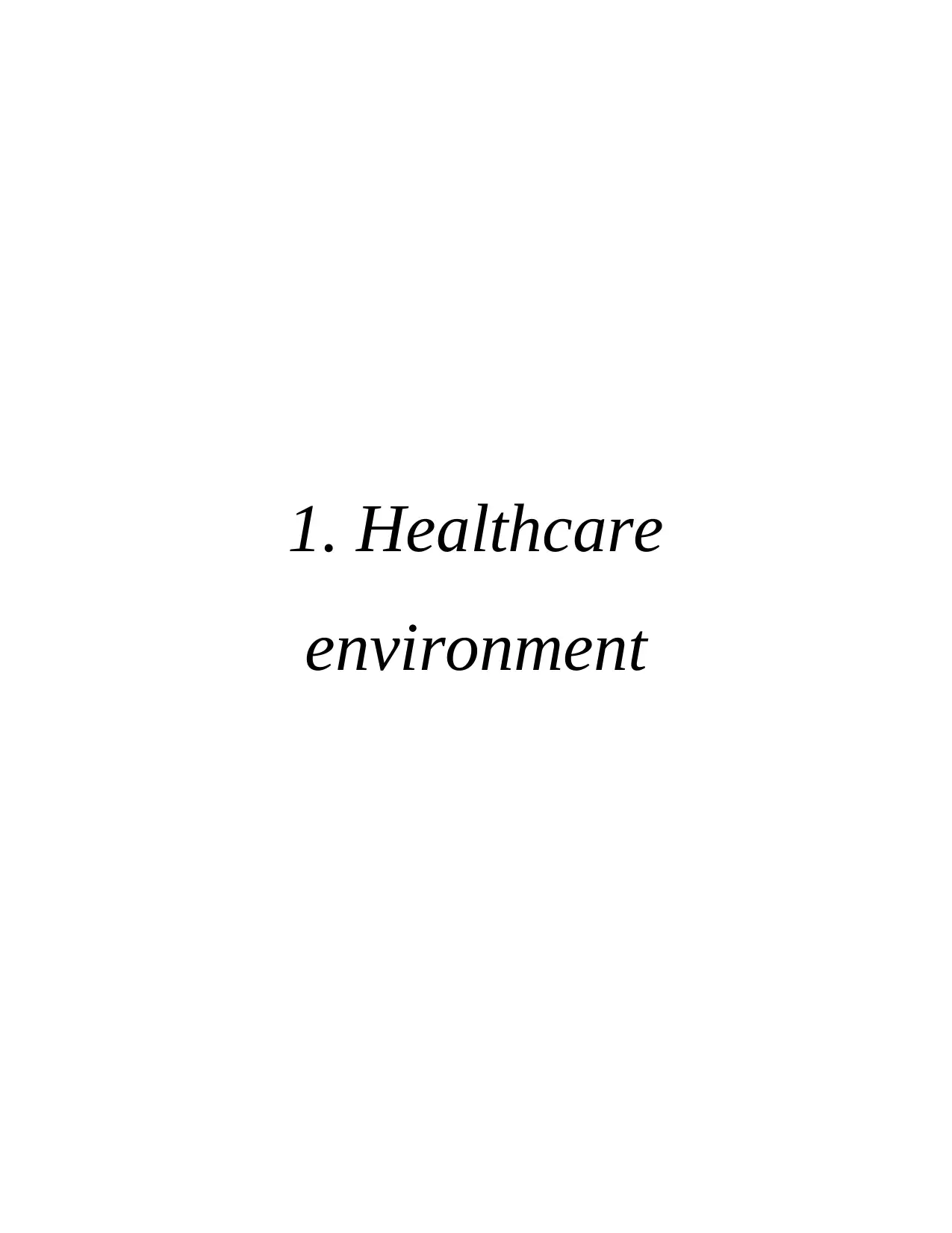
1. Healthcare
environment
environment
Paraphrase This Document
Need a fresh take? Get an instant paraphrase of this document with our AI Paraphraser
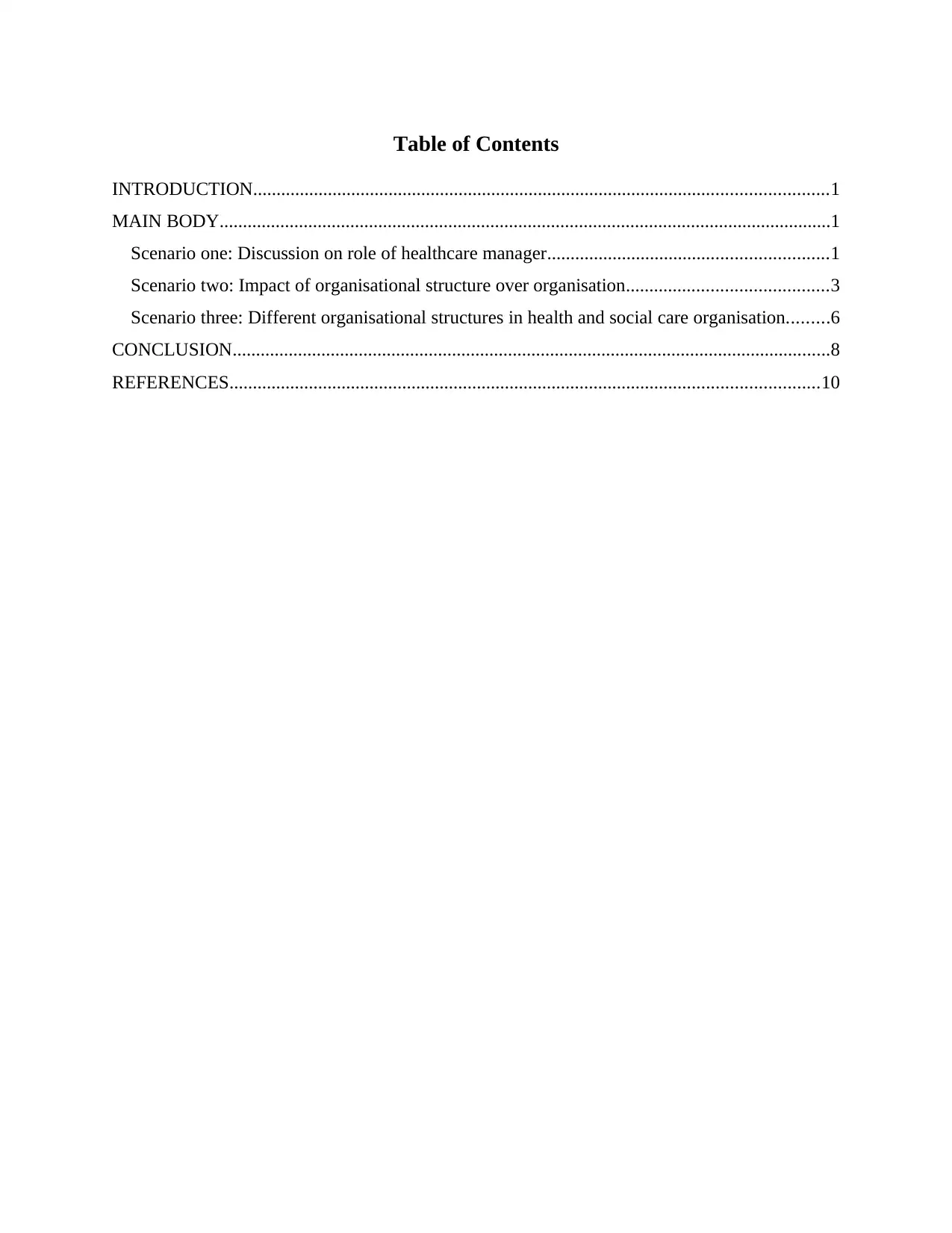
Table of Contents
INTRODUCTION...........................................................................................................................1
MAIN BODY...................................................................................................................................1
Scenario one: Discussion on role of healthcare manager............................................................1
Scenario two: Impact of organisational structure over organisation...........................................3
Scenario three: Different organisational structures in health and social care organisation.........6
CONCLUSION................................................................................................................................8
REFERENCES..............................................................................................................................10
INTRODUCTION...........................................................................................................................1
MAIN BODY...................................................................................................................................1
Scenario one: Discussion on role of healthcare manager............................................................1
Scenario two: Impact of organisational structure over organisation...........................................3
Scenario three: Different organisational structures in health and social care organisation.........6
CONCLUSION................................................................................................................................8
REFERENCES..............................................................................................................................10

⊘ This is a preview!⊘
Do you want full access?
Subscribe today to unlock all pages.

Trusted by 1+ million students worldwide
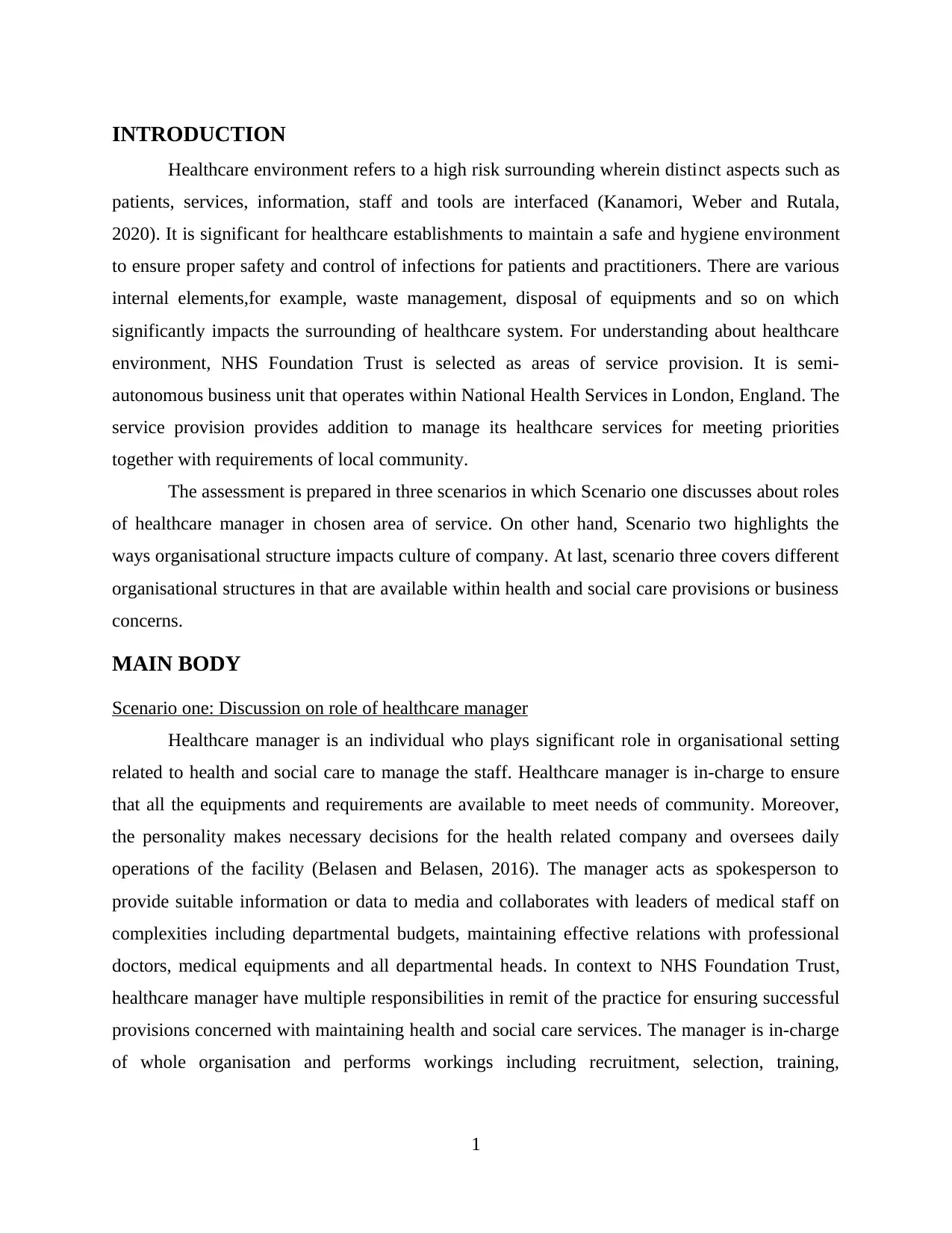
INTRODUCTION
Healthcare environment refers to a high risk surrounding wherein distinct aspects such as
patients, services, information, staff and tools are interfaced (Kanamori, Weber and Rutala,
2020). It is significant for healthcare establishments to maintain a safe and hygiene environment
to ensure proper safety and control of infections for patients and practitioners. There are various
internal elements,for example, waste management, disposal of equipments and so on which
significantly impacts the surrounding of healthcare system. For understanding about healthcare
environment, NHS Foundation Trust is selected as areas of service provision. It is semi-
autonomous business unit that operates within National Health Services in London, England. The
service provision provides addition to manage its healthcare services for meeting priorities
together with requirements of local community.
The assessment is prepared in three scenarios in which Scenario one discusses about roles
of healthcare manager in chosen area of service. On other hand, Scenario two highlights the
ways organisational structure impacts culture of company. At last, scenario three covers different
organisational structures in that are available within health and social care provisions or business
concerns.
MAIN BODY
Scenario one: Discussion on role of healthcare manager
Healthcare manager is an individual who plays significant role in organisational setting
related to health and social care to manage the staff. Healthcare manager is in-charge to ensure
that all the equipments and requirements are available to meet needs of community. Moreover,
the personality makes necessary decisions for the health related company and oversees daily
operations of the facility (Belasen and Belasen, 2016). The manager acts as spokesperson to
provide suitable information or data to media and collaborates with leaders of medical staff on
complexities including departmental budgets, maintaining effective relations with professional
doctors, medical equipments and all departmental heads. In context to NHS Foundation Trust,
healthcare manager have multiple responsibilities in remit of the practice for ensuring successful
provisions concerned with maintaining health and social care services. The manager is in-charge
of whole organisation and performs workings including recruitment, selection, training,
1
Healthcare environment refers to a high risk surrounding wherein distinct aspects such as
patients, services, information, staff and tools are interfaced (Kanamori, Weber and Rutala,
2020). It is significant for healthcare establishments to maintain a safe and hygiene environment
to ensure proper safety and control of infections for patients and practitioners. There are various
internal elements,for example, waste management, disposal of equipments and so on which
significantly impacts the surrounding of healthcare system. For understanding about healthcare
environment, NHS Foundation Trust is selected as areas of service provision. It is semi-
autonomous business unit that operates within National Health Services in London, England. The
service provision provides addition to manage its healthcare services for meeting priorities
together with requirements of local community.
The assessment is prepared in three scenarios in which Scenario one discusses about roles
of healthcare manager in chosen area of service. On other hand, Scenario two highlights the
ways organisational structure impacts culture of company. At last, scenario three covers different
organisational structures in that are available within health and social care provisions or business
concerns.
MAIN BODY
Scenario one: Discussion on role of healthcare manager
Healthcare manager is an individual who plays significant role in organisational setting
related to health and social care to manage the staff. Healthcare manager is in-charge to ensure
that all the equipments and requirements are available to meet needs of community. Moreover,
the personality makes necessary decisions for the health related company and oversees daily
operations of the facility (Belasen and Belasen, 2016). The manager acts as spokesperson to
provide suitable information or data to media and collaborates with leaders of medical staff on
complexities including departmental budgets, maintaining effective relations with professional
doctors, medical equipments and all departmental heads. In context to NHS Foundation Trust,
healthcare manager have multiple responsibilities in remit of the practice for ensuring successful
provisions concerned with maintaining health and social care services. The manager is in-charge
of whole organisation and performs workings including recruitment, selection, training,
1
Paraphrase This Document
Need a fresh take? Get an instant paraphrase of this document with our AI Paraphraser
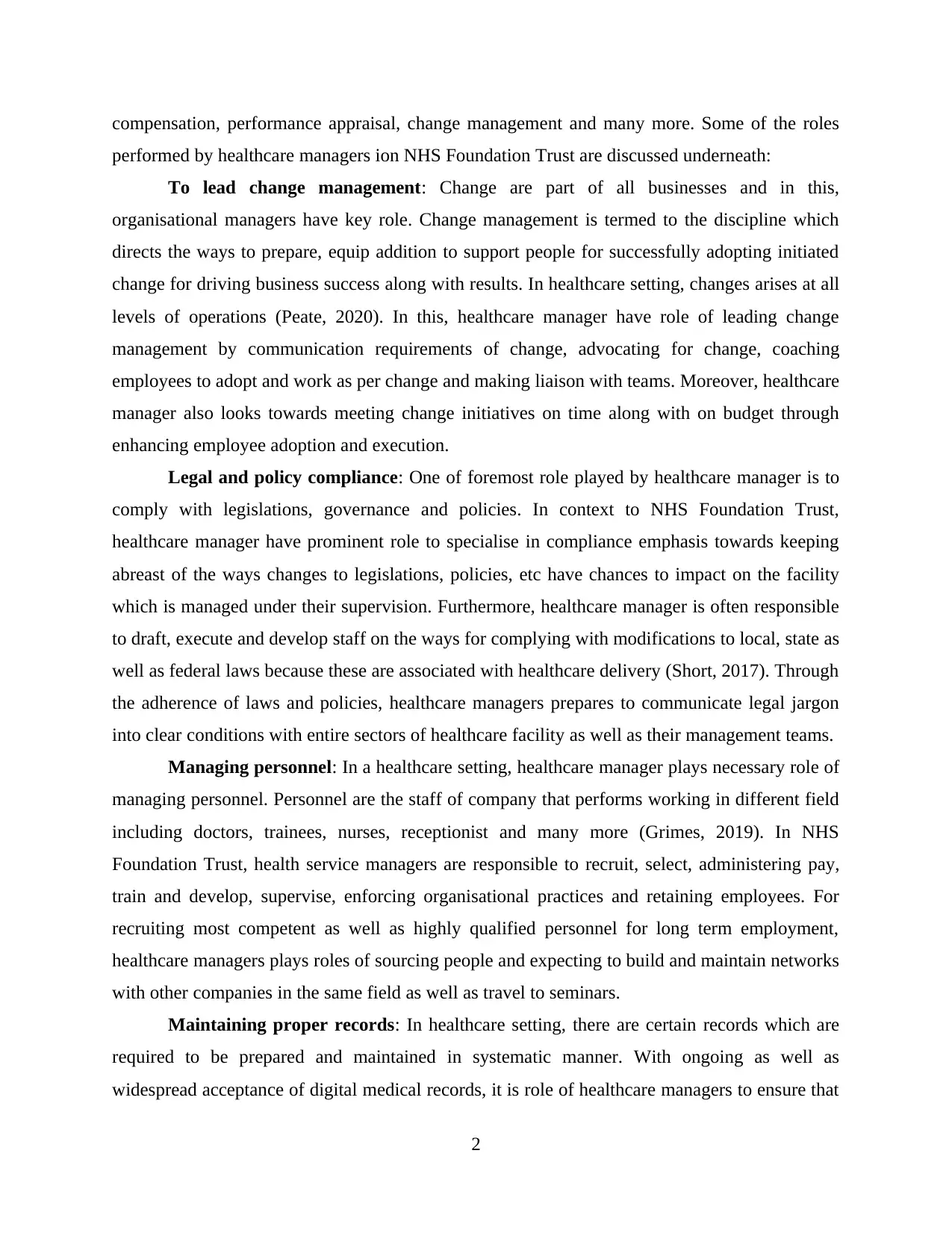
compensation, performance appraisal, change management and many more. Some of the roles
performed by healthcare managers ion NHS Foundation Trust are discussed underneath:
To lead change management: Change are part of all businesses and in this,
organisational managers have key role. Change management is termed to the discipline which
directs the ways to prepare, equip addition to support people for successfully adopting initiated
change for driving business success along with results. In healthcare setting, changes arises at all
levels of operations (Peate, 2020). In this, healthcare manager have role of leading change
management by communication requirements of change, advocating for change, coaching
employees to adopt and work as per change and making liaison with teams. Moreover, healthcare
manager also looks towards meeting change initiatives on time along with on budget through
enhancing employee adoption and execution.
Legal and policy compliance: One of foremost role played by healthcare manager is to
comply with legislations, governance and policies. In context to NHS Foundation Trust,
healthcare manager have prominent role to specialise in compliance emphasis towards keeping
abreast of the ways changes to legislations, policies, etc have chances to impact on the facility
which is managed under their supervision. Furthermore, healthcare manager is often responsible
to draft, execute and develop staff on the ways for complying with modifications to local, state as
well as federal laws because these are associated with healthcare delivery (Short, 2017). Through
the adherence of laws and policies, healthcare managers prepares to communicate legal jargon
into clear conditions with entire sectors of healthcare facility as well as their management teams.
Managing personnel: In a healthcare setting, healthcare manager plays necessary role of
managing personnel. Personnel are the staff of company that performs working in different field
including doctors, trainees, nurses, receptionist and many more (Grimes, 2019). In NHS
Foundation Trust, health service managers are responsible to recruit, select, administering pay,
train and develop, supervise, enforcing organisational practices and retaining employees. For
recruiting most competent as well as highly qualified personnel for long term employment,
healthcare managers plays roles of sourcing people and expecting to build and maintain networks
with other companies in the same field as well as travel to seminars.
Maintaining proper records: In healthcare setting, there are certain records which are
required to be prepared and maintained in systematic manner. With ongoing as well as
widespread acceptance of digital medical records, it is role of healthcare managers to ensure that
2
performed by healthcare managers ion NHS Foundation Trust are discussed underneath:
To lead change management: Change are part of all businesses and in this,
organisational managers have key role. Change management is termed to the discipline which
directs the ways to prepare, equip addition to support people for successfully adopting initiated
change for driving business success along with results. In healthcare setting, changes arises at all
levels of operations (Peate, 2020). In this, healthcare manager have role of leading change
management by communication requirements of change, advocating for change, coaching
employees to adopt and work as per change and making liaison with teams. Moreover, healthcare
manager also looks towards meeting change initiatives on time along with on budget through
enhancing employee adoption and execution.
Legal and policy compliance: One of foremost role played by healthcare manager is to
comply with legislations, governance and policies. In context to NHS Foundation Trust,
healthcare manager have prominent role to specialise in compliance emphasis towards keeping
abreast of the ways changes to legislations, policies, etc have chances to impact on the facility
which is managed under their supervision. Furthermore, healthcare manager is often responsible
to draft, execute and develop staff on the ways for complying with modifications to local, state as
well as federal laws because these are associated with healthcare delivery (Short, 2017). Through
the adherence of laws and policies, healthcare managers prepares to communicate legal jargon
into clear conditions with entire sectors of healthcare facility as well as their management teams.
Managing personnel: In a healthcare setting, healthcare manager plays necessary role of
managing personnel. Personnel are the staff of company that performs working in different field
including doctors, trainees, nurses, receptionist and many more (Grimes, 2019). In NHS
Foundation Trust, health service managers are responsible to recruit, select, administering pay,
train and develop, supervise, enforcing organisational practices and retaining employees. For
recruiting most competent as well as highly qualified personnel for long term employment,
healthcare managers plays roles of sourcing people and expecting to build and maintain networks
with other companies in the same field as well as travel to seminars.
Maintaining proper records: In healthcare setting, there are certain records which are
required to be prepared and maintained in systematic manner. With ongoing as well as
widespread acceptance of digital medical records, it is role of healthcare managers to ensure that
2
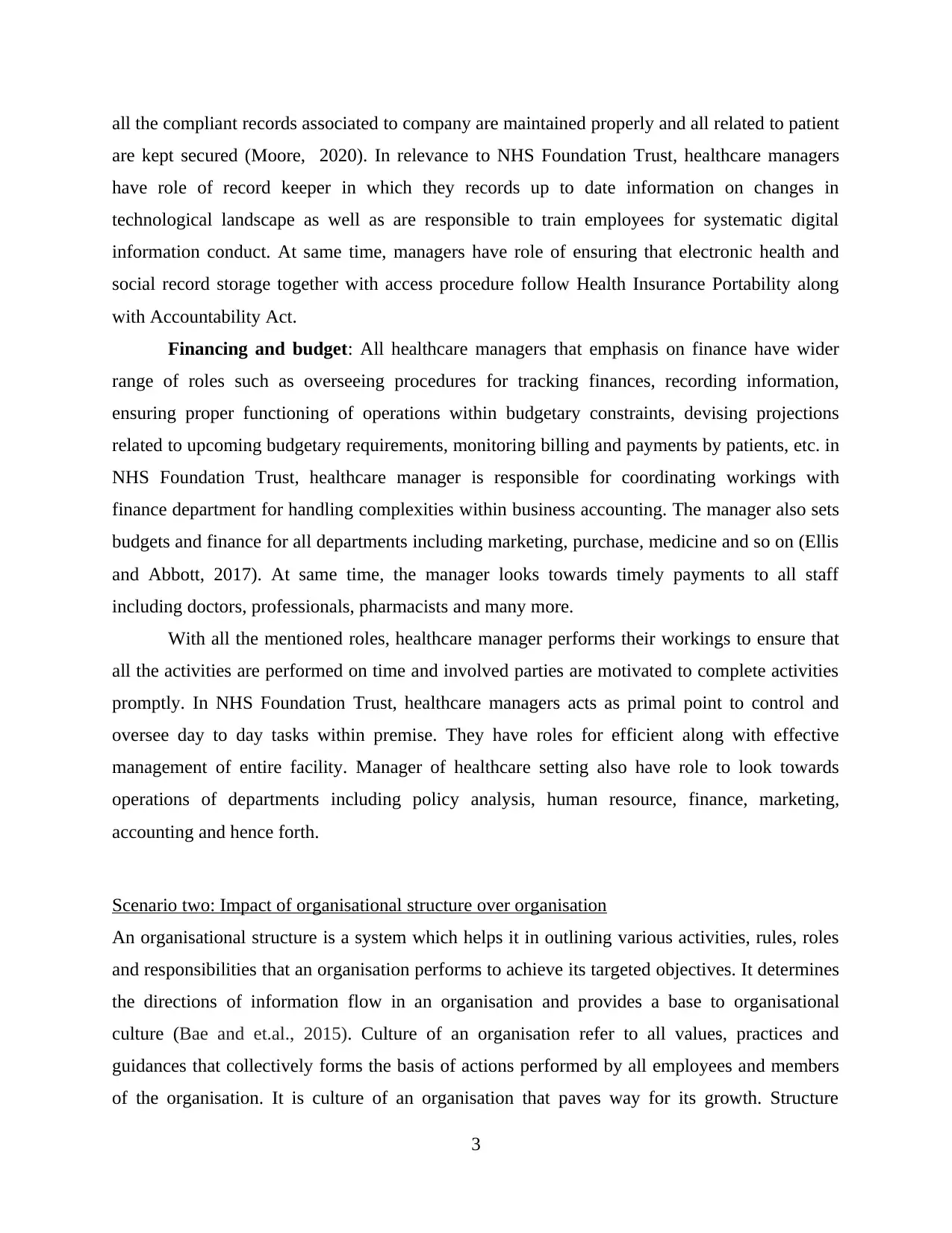
all the compliant records associated to company are maintained properly and all related to patient
are kept secured (Moore, 2020). In relevance to NHS Foundation Trust, healthcare managers
have role of record keeper in which they records up to date information on changes in
technological landscape as well as are responsible to train employees for systematic digital
information conduct. At same time, managers have role of ensuring that electronic health and
social record storage together with access procedure follow Health Insurance Portability along
with Accountability Act.
Financing and budget: All healthcare managers that emphasis on finance have wider
range of roles such as overseeing procedures for tracking finances, recording information,
ensuring proper functioning of operations within budgetary constraints, devising projections
related to upcoming budgetary requirements, monitoring billing and payments by patients, etc. in
NHS Foundation Trust, healthcare manager is responsible for coordinating workings with
finance department for handling complexities within business accounting. The manager also sets
budgets and finance for all departments including marketing, purchase, medicine and so on (Ellis
and Abbott, 2017). At same time, the manager looks towards timely payments to all staff
including doctors, professionals, pharmacists and many more.
With all the mentioned roles, healthcare manager performs their workings to ensure that
all the activities are performed on time and involved parties are motivated to complete activities
promptly. In NHS Foundation Trust, healthcare managers acts as primal point to control and
oversee day to day tasks within premise. They have roles for efficient along with effective
management of entire facility. Manager of healthcare setting also have role to look towards
operations of departments including policy analysis, human resource, finance, marketing,
accounting and hence forth.
Scenario two: Impact of organisational structure over organisation
An organisational structure is a system which helps it in outlining various activities, rules, roles
and responsibilities that an organisation performs to achieve its targeted objectives. It determines
the directions of information flow in an organisation and provides a base to organisational
culture (Bae and et.al., 2015). Culture of an organisation refer to all values, practices and
guidances that collectively forms the basis of actions performed by all employees and members
of the organisation. It is culture of an organisation that paves way for its growth. Structure
3
are kept secured (Moore, 2020). In relevance to NHS Foundation Trust, healthcare managers
have role of record keeper in which they records up to date information on changes in
technological landscape as well as are responsible to train employees for systematic digital
information conduct. At same time, managers have role of ensuring that electronic health and
social record storage together with access procedure follow Health Insurance Portability along
with Accountability Act.
Financing and budget: All healthcare managers that emphasis on finance have wider
range of roles such as overseeing procedures for tracking finances, recording information,
ensuring proper functioning of operations within budgetary constraints, devising projections
related to upcoming budgetary requirements, monitoring billing and payments by patients, etc. in
NHS Foundation Trust, healthcare manager is responsible for coordinating workings with
finance department for handling complexities within business accounting. The manager also sets
budgets and finance for all departments including marketing, purchase, medicine and so on (Ellis
and Abbott, 2017). At same time, the manager looks towards timely payments to all staff
including doctors, professionals, pharmacists and many more.
With all the mentioned roles, healthcare manager performs their workings to ensure that
all the activities are performed on time and involved parties are motivated to complete activities
promptly. In NHS Foundation Trust, healthcare managers acts as primal point to control and
oversee day to day tasks within premise. They have roles for efficient along with effective
management of entire facility. Manager of healthcare setting also have role to look towards
operations of departments including policy analysis, human resource, finance, marketing,
accounting and hence forth.
Scenario two: Impact of organisational structure over organisation
An organisational structure is a system which helps it in outlining various activities, rules, roles
and responsibilities that an organisation performs to achieve its targeted objectives. It determines
the directions of information flow in an organisation and provides a base to organisational
culture (Bae and et.al., 2015). Culture of an organisation refer to all values, practices and
guidances that collectively forms the basis of actions performed by all employees and members
of the organisation. It is culture of an organisation that paves way for its growth. Structure
3
⊘ This is a preview!⊘
Do you want full access?
Subscribe today to unlock all pages.

Trusted by 1+ million students worldwide

impacts culture of an organisation in healthcare since its obtains its design from it. In healthcare
organisations, it is all the more important to have a well defined culture within structure since,
management position can not be confined to top level as all the operations at all levels are
important and complex. There are various theories on organisational culture. One such model
was presented by Charles Handy, who defined a four classes of organisational culture:
Power culture – Such organisations where power is wielded by only few individuals are
called to be having power culture (Borkowski and Meese, 2020). These influential leaders decide
rules and regulations to be followed in the organisation even if they are against organisational
structure. It can also lead to organisational culture turning toxic. Employee performance is
judged by their results not process of development. Such culture can encourage quick decision
making but are never in the long run interest of the organisation for it is not supportive to
development of the employees' personalities. In healthcare, such culture is useful when there is
emergency conditions and urgent decision-making is required.
Role Culture – Those organisations where culture is defined by the structure and the
roles provided by it, are said to have role culture (Chandler and et.al., 2016). Power and authority
provided to employees are also decided by their designation in a typical long chain command
structure. They are supposedly rigid in structure where everyone is aware of their responsibilities
and the way they have to perform it. This reduces the chances of development of creativity and
4
Illustration 1: Handy's Model of Organisational Culture,
2018
organisations, it is all the more important to have a well defined culture within structure since,
management position can not be confined to top level as all the operations at all levels are
important and complex. There are various theories on organisational culture. One such model
was presented by Charles Handy, who defined a four classes of organisational culture:
Power culture – Such organisations where power is wielded by only few individuals are
called to be having power culture (Borkowski and Meese, 2020). These influential leaders decide
rules and regulations to be followed in the organisation even if they are against organisational
structure. It can also lead to organisational culture turning toxic. Employee performance is
judged by their results not process of development. Such culture can encourage quick decision
making but are never in the long run interest of the organisation for it is not supportive to
development of the employees' personalities. In healthcare, such culture is useful when there is
emergency conditions and urgent decision-making is required.
Role Culture – Those organisations where culture is defined by the structure and the
roles provided by it, are said to have role culture (Chandler and et.al., 2016). Power and authority
provided to employees are also decided by their designation in a typical long chain command
structure. They are supposedly rigid in structure where everyone is aware of their responsibilities
and the way they have to perform it. This reduces the chances of development of creativity and
4
Illustration 1: Handy's Model of Organisational Culture,
2018
Paraphrase This Document
Need a fresh take? Get an instant paraphrase of this document with our AI Paraphraser

flexibility in the organisational structure and employees. Such organisations are bureaucratic and
hence, slow in decision-making. In healthcare, such culture is generally practised in different
department of an organisation.
Task culture – Those organisations where teams are divided according to the
responsibilities they have to perform, are called to be having task culture. Such teams are formed
to address specific objectives, problems or projects. Task is the most important thing in the team
and power, role and responsibilities are decided on its basis. Power is delegated by the team
leader in accordance to capabilities, capacities and specialities of the team member and the status
of the task. Effectiveness of this culture depends on team dynamics and performance. When right
skills are mixed with appropriate leadership among personalities which are dedicated enough to
achieve not just success but excellence in whatever task they have to perform, this culture is able
to generate incredible results. This culture is able to encourage employees, improve their
productivity and enhance their creativity. Such culture is practised in healthcare, when new
interns are included in team by senior practitioners.
Person culture – Those organisations in which certain individuals come together to form
an organisation, are said to be having person culture (Crema and Verbano, 2015). In such
organisations, individuals consider themselves superior to the organisation. These organisations
usually comprises of professional firms like of accountants, lawyers, architect, etc. They work
together and form an organisation. Therefore, such organisations generally have a flat structure
and power is yielded by all individuals in the group. This culture is found in small clinics in
which one or two doctors practise together in healthcare sector.
In the given scenario, a small hierarchical GP surgery is joining together with a flat-
structured social enterprise run by social workers. For the sake of easy understanding of this
scenario, a social enterprise named Care Home is considered. It is a NGO which has flat
structure and provides nursing and healthcare facilities at home. They have a merger with a GP
surgery which has a well defined small hierarchical structure. Two services with two different
structures have come together. This is bound to make an impact over existing culture of both the
organisations. Therefore, it is important for Care Home and GP surgery management teams to
come together and discuss things in details so that there is not confusion left later.
Structural change: Both the teams shall indulge in discussion related to structural
change related to command structure, communication channel, services offered, reporting, etc.
5
hence, slow in decision-making. In healthcare, such culture is generally practised in different
department of an organisation.
Task culture – Those organisations where teams are divided according to the
responsibilities they have to perform, are called to be having task culture. Such teams are formed
to address specific objectives, problems or projects. Task is the most important thing in the team
and power, role and responsibilities are decided on its basis. Power is delegated by the team
leader in accordance to capabilities, capacities and specialities of the team member and the status
of the task. Effectiveness of this culture depends on team dynamics and performance. When right
skills are mixed with appropriate leadership among personalities which are dedicated enough to
achieve not just success but excellence in whatever task they have to perform, this culture is able
to generate incredible results. This culture is able to encourage employees, improve their
productivity and enhance their creativity. Such culture is practised in healthcare, when new
interns are included in team by senior practitioners.
Person culture – Those organisations in which certain individuals come together to form
an organisation, are said to be having person culture (Crema and Verbano, 2015). In such
organisations, individuals consider themselves superior to the organisation. These organisations
usually comprises of professional firms like of accountants, lawyers, architect, etc. They work
together and form an organisation. Therefore, such organisations generally have a flat structure
and power is yielded by all individuals in the group. This culture is found in small clinics in
which one or two doctors practise together in healthcare sector.
In the given scenario, a small hierarchical GP surgery is joining together with a flat-
structured social enterprise run by social workers. For the sake of easy understanding of this
scenario, a social enterprise named Care Home is considered. It is a NGO which has flat
structure and provides nursing and healthcare facilities at home. They have a merger with a GP
surgery which has a well defined small hierarchical structure. Two services with two different
structures have come together. This is bound to make an impact over existing culture of both the
organisations. Therefore, it is important for Care Home and GP surgery management teams to
come together and discuss things in details so that there is not confusion left later.
Structural change: Both the teams shall indulge in discussion related to structural
change related to command structure, communication channel, services offered, reporting, etc.
5

for all these are very important to maintain a healthy organisational culture in both the services
separately as well as jointly, while collaborating and working together (Provost and et.al., 2015).
Pre-merger due diligence: Both the services and organisations must be having their own
vision and mission statement. They shall discuss to create a joint long-term objectives. Also, they
must include all of their employees, workers and associates in the discussion so that they are also
clear as to what they have to expect from new settings and what is expectation from them in new
setting.
Phased change: Organisation is in healthcare services and any confusion among
employees, staff and volunteers can lead to reduction in quality of services. Therefore, changes
must be implemented in phases. In first phase, staff shall be told about the changes in services. In
next phase, they should be allowed to be comfortable in new arrangement.
Scenario three: Different organisational structures in health and social care organisation.
Organisational structure determines the layers of management within its staff in an organisation
and also, clarifies the command chain and communication channels. There are various structures
that a healthcare organisation can adopt. Few are below mentioned:
Flat structure – This structures is characterised with very few layers of management.
Managers are supposed to be having a wide span of control as there will be lot of subordinates
within same managers (Robbins and Davidhizar, 2020). Chain of command is short and
communication is easier in it. If a new healthcare organisation adopts flat structure, it will have
following advantages and disadvantages:
Advantages: This type of structure has less command levels and will benefit new
organisation with lower operational cost, saving the cost of hiring different management levels.
Healthcare organisations required quick communication and flat structure will help with less
bureaucracy and facilitate easier and quicker decision-making. Effective interaction between top
management and employees will take place and the organisation will look like a big team. This
will increase staff spirit as well.
Disadvantages: This structure is characterised by one manager managing lots of
subordinates. If the manager is not able to manage effectively, organisational operations will go
haywire and this can not only result in increased costs but will also lead to reduced goodwill, in
case anything happens to any patients (Zingg and et.al., 2015). Lack of layers also result in less
6
separately as well as jointly, while collaborating and working together (Provost and et.al., 2015).
Pre-merger due diligence: Both the services and organisations must be having their own
vision and mission statement. They shall discuss to create a joint long-term objectives. Also, they
must include all of their employees, workers and associates in the discussion so that they are also
clear as to what they have to expect from new settings and what is expectation from them in new
setting.
Phased change: Organisation is in healthcare services and any confusion among
employees, staff and volunteers can lead to reduction in quality of services. Therefore, changes
must be implemented in phases. In first phase, staff shall be told about the changes in services. In
next phase, they should be allowed to be comfortable in new arrangement.
Scenario three: Different organisational structures in health and social care organisation.
Organisational structure determines the layers of management within its staff in an organisation
and also, clarifies the command chain and communication channels. There are various structures
that a healthcare organisation can adopt. Few are below mentioned:
Flat structure – This structures is characterised with very few layers of management.
Managers are supposed to be having a wide span of control as there will be lot of subordinates
within same managers (Robbins and Davidhizar, 2020). Chain of command is short and
communication is easier in it. If a new healthcare organisation adopts flat structure, it will have
following advantages and disadvantages:
Advantages: This type of structure has less command levels and will benefit new
organisation with lower operational cost, saving the cost of hiring different management levels.
Healthcare organisations required quick communication and flat structure will help with less
bureaucracy and facilitate easier and quicker decision-making. Effective interaction between top
management and employees will take place and the organisation will look like a big team. This
will increase staff spirit as well.
Disadvantages: This structure is characterised by one manager managing lots of
subordinates. If the manager is not able to manage effectively, organisational operations will go
haywire and this can not only result in increased costs but will also lead to reduced goodwill, in
case anything happens to any patients (Zingg and et.al., 2015). Lack of layers also result in less
6
⊘ This is a preview!⊘
Do you want full access?
Subscribe today to unlock all pages.

Trusted by 1+ million students worldwide
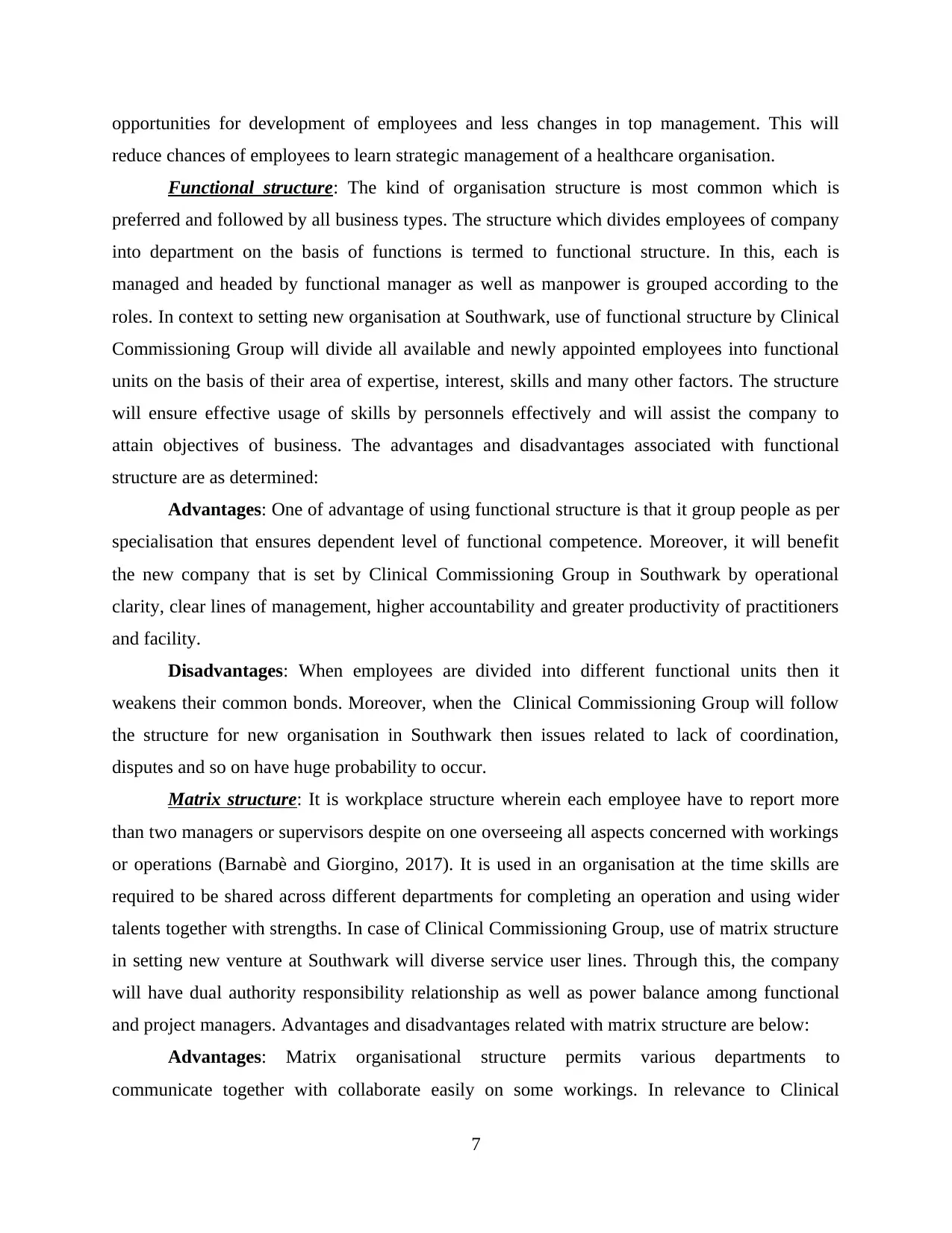
opportunities for development of employees and less changes in top management. This will
reduce chances of employees to learn strategic management of a healthcare organisation.
Functional structure: The kind of organisation structure is most common which is
preferred and followed by all business types. The structure which divides employees of company
into department on the basis of functions is termed to functional structure. In this, each is
managed and headed by functional manager as well as manpower is grouped according to the
roles. In context to setting new organisation at Southwark, use of functional structure by Clinical
Commissioning Group will divide all available and newly appointed employees into functional
units on the basis of their area of expertise, interest, skills and many other factors. The structure
will ensure effective usage of skills by personnels effectively and will assist the company to
attain objectives of business. The advantages and disadvantages associated with functional
structure are as determined:
Advantages: One of advantage of using functional structure is that it group people as per
specialisation that ensures dependent level of functional competence. Moreover, it will benefit
the new company that is set by Clinical Commissioning Group in Southwark by operational
clarity, clear lines of management, higher accountability and greater productivity of practitioners
and facility.
Disadvantages: When employees are divided into different functional units then it
weakens their common bonds. Moreover, when the Clinical Commissioning Group will follow
the structure for new organisation in Southwark then issues related to lack of coordination,
disputes and so on have huge probability to occur.
Matrix structure: It is workplace structure wherein each employee have to report more
than two managers or supervisors despite on one overseeing all aspects concerned with workings
or operations (Barnabè and Giorgino, 2017). It is used in an organisation at the time skills are
required to be shared across different departments for completing an operation and using wider
talents together with strengths. In case of Clinical Commissioning Group, use of matrix structure
in setting new venture at Southwark will diverse service user lines. Through this, the company
will have dual authority responsibility relationship as well as power balance among functional
and project managers. Advantages and disadvantages related with matrix structure are below:
Advantages: Matrix organisational structure permits various departments to
communicate together with collaborate easily on some workings. In relevance to Clinical
7
reduce chances of employees to learn strategic management of a healthcare organisation.
Functional structure: The kind of organisation structure is most common which is
preferred and followed by all business types. The structure which divides employees of company
into department on the basis of functions is termed to functional structure. In this, each is
managed and headed by functional manager as well as manpower is grouped according to the
roles. In context to setting new organisation at Southwark, use of functional structure by Clinical
Commissioning Group will divide all available and newly appointed employees into functional
units on the basis of their area of expertise, interest, skills and many other factors. The structure
will ensure effective usage of skills by personnels effectively and will assist the company to
attain objectives of business. The advantages and disadvantages associated with functional
structure are as determined:
Advantages: One of advantage of using functional structure is that it group people as per
specialisation that ensures dependent level of functional competence. Moreover, it will benefit
the new company that is set by Clinical Commissioning Group in Southwark by operational
clarity, clear lines of management, higher accountability and greater productivity of practitioners
and facility.
Disadvantages: When employees are divided into different functional units then it
weakens their common bonds. Moreover, when the Clinical Commissioning Group will follow
the structure for new organisation in Southwark then issues related to lack of coordination,
disputes and so on have huge probability to occur.
Matrix structure: It is workplace structure wherein each employee have to report more
than two managers or supervisors despite on one overseeing all aspects concerned with workings
or operations (Barnabè and Giorgino, 2017). It is used in an organisation at the time skills are
required to be shared across different departments for completing an operation and using wider
talents together with strengths. In case of Clinical Commissioning Group, use of matrix structure
in setting new venture at Southwark will diverse service user lines. Through this, the company
will have dual authority responsibility relationship as well as power balance among functional
and project managers. Advantages and disadvantages related with matrix structure are below:
Advantages: Matrix organisational structure permits various departments to
communicate together with collaborate easily on some workings. In relevance to Clinical
7
Paraphrase This Document
Need a fresh take? Get an instant paraphrase of this document with our AI Paraphraser
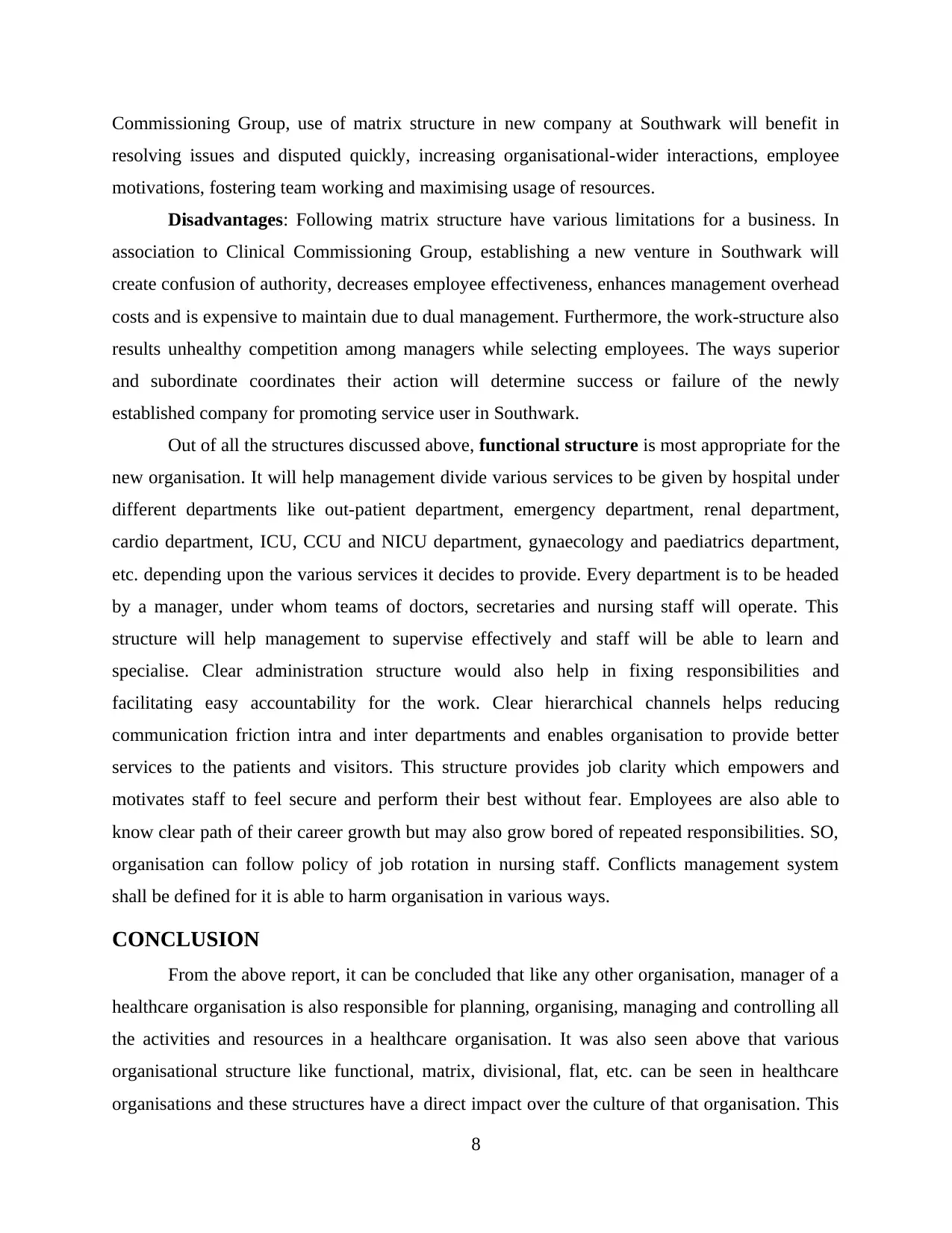
Commissioning Group, use of matrix structure in new company at Southwark will benefit in
resolving issues and disputed quickly, increasing organisational-wider interactions, employee
motivations, fostering team working and maximising usage of resources.
Disadvantages: Following matrix structure have various limitations for a business. In
association to Clinical Commissioning Group, establishing a new venture in Southwark will
create confusion of authority, decreases employee effectiveness, enhances management overhead
costs and is expensive to maintain due to dual management. Furthermore, the work-structure also
results unhealthy competition among managers while selecting employees. The ways superior
and subordinate coordinates their action will determine success or failure of the newly
established company for promoting service user in Southwark.
Out of all the structures discussed above, functional structure is most appropriate for the
new organisation. It will help management divide various services to be given by hospital under
different departments like out-patient department, emergency department, renal department,
cardio department, ICU, CCU and NICU department, gynaecology and paediatrics department,
etc. depending upon the various services it decides to provide. Every department is to be headed
by a manager, under whom teams of doctors, secretaries and nursing staff will operate. This
structure will help management to supervise effectively and staff will be able to learn and
specialise. Clear administration structure would also help in fixing responsibilities and
facilitating easy accountability for the work. Clear hierarchical channels helps reducing
communication friction intra and inter departments and enables organisation to provide better
services to the patients and visitors. This structure provides job clarity which empowers and
motivates staff to feel secure and perform their best without fear. Employees are also able to
know clear path of their career growth but may also grow bored of repeated responsibilities. SO,
organisation can follow policy of job rotation in nursing staff. Conflicts management system
shall be defined for it is able to harm organisation in various ways.
CONCLUSION
From the above report, it can be concluded that like any other organisation, manager of a
healthcare organisation is also responsible for planning, organising, managing and controlling all
the activities and resources in a healthcare organisation. It was also seen above that various
organisational structure like functional, matrix, divisional, flat, etc. can be seen in healthcare
organisations and these structures have a direct impact over the culture of that organisation. This
8
resolving issues and disputed quickly, increasing organisational-wider interactions, employee
motivations, fostering team working and maximising usage of resources.
Disadvantages: Following matrix structure have various limitations for a business. In
association to Clinical Commissioning Group, establishing a new venture in Southwark will
create confusion of authority, decreases employee effectiveness, enhances management overhead
costs and is expensive to maintain due to dual management. Furthermore, the work-structure also
results unhealthy competition among managers while selecting employees. The ways superior
and subordinate coordinates their action will determine success or failure of the newly
established company for promoting service user in Southwark.
Out of all the structures discussed above, functional structure is most appropriate for the
new organisation. It will help management divide various services to be given by hospital under
different departments like out-patient department, emergency department, renal department,
cardio department, ICU, CCU and NICU department, gynaecology and paediatrics department,
etc. depending upon the various services it decides to provide. Every department is to be headed
by a manager, under whom teams of doctors, secretaries and nursing staff will operate. This
structure will help management to supervise effectively and staff will be able to learn and
specialise. Clear administration structure would also help in fixing responsibilities and
facilitating easy accountability for the work. Clear hierarchical channels helps reducing
communication friction intra and inter departments and enables organisation to provide better
services to the patients and visitors. This structure provides job clarity which empowers and
motivates staff to feel secure and perform their best without fear. Employees are also able to
know clear path of their career growth but may also grow bored of repeated responsibilities. SO,
organisation can follow policy of job rotation in nursing staff. Conflicts management system
shall be defined for it is able to harm organisation in various ways.
CONCLUSION
From the above report, it can be concluded that like any other organisation, manager of a
healthcare organisation is also responsible for planning, organising, managing and controlling all
the activities and resources in a healthcare organisation. It was also seen above that various
organisational structure like functional, matrix, divisional, flat, etc. can be seen in healthcare
organisations and these structures have a direct impact over the culture of that organisation. This
8
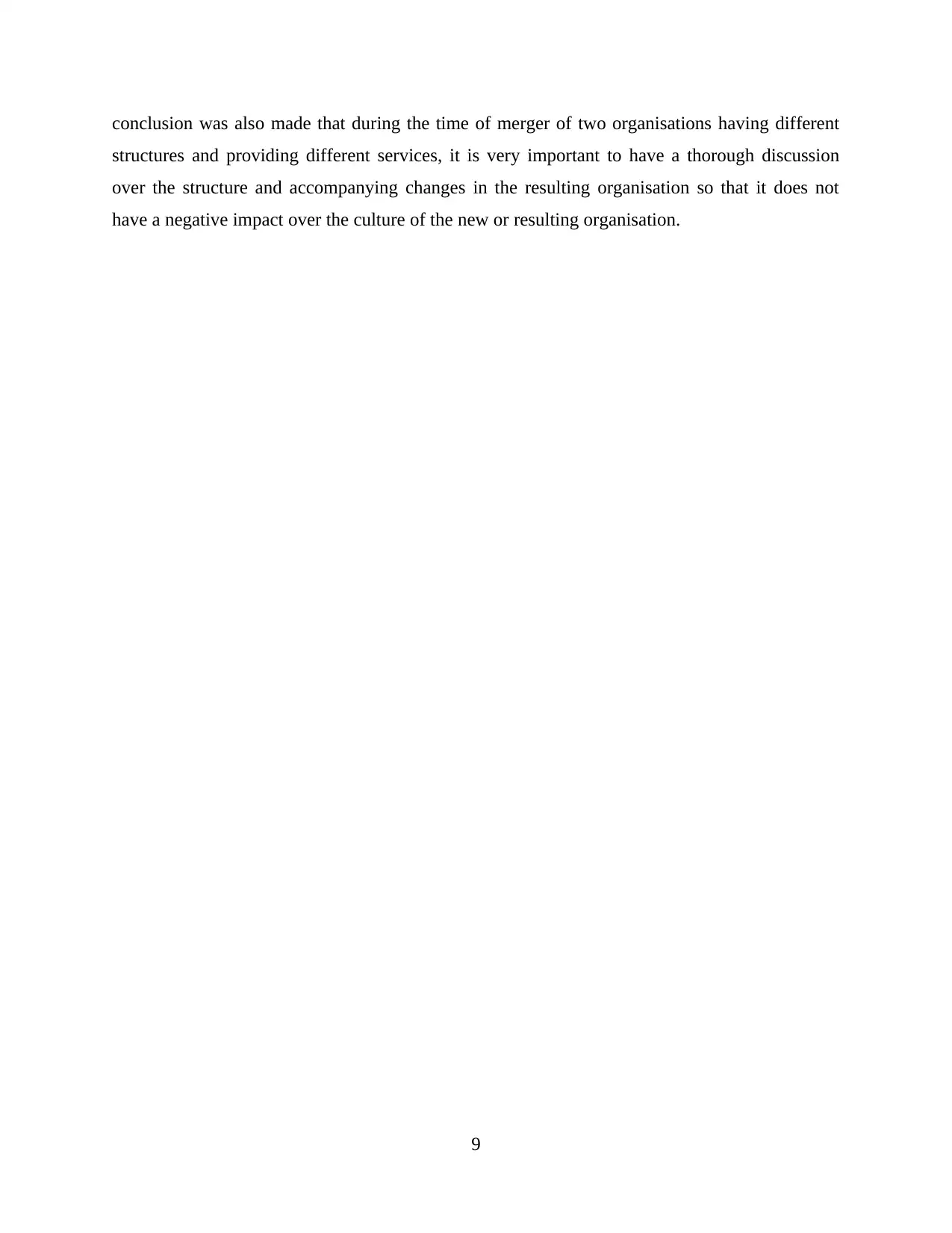
conclusion was also made that during the time of merger of two organisations having different
structures and providing different services, it is very important to have a thorough discussion
over the structure and accompanying changes in the resulting organisation so that it does not
have a negative impact over the culture of the new or resulting organisation.
9
structures and providing different services, it is very important to have a thorough discussion
over the structure and accompanying changes in the resulting organisation so that it does not
have a negative impact over the culture of the new or resulting organisation.
9
⊘ This is a preview!⊘
Do you want full access?
Subscribe today to unlock all pages.

Trusted by 1+ million students worldwide
1 out of 13
Related Documents
Your All-in-One AI-Powered Toolkit for Academic Success.
+13062052269
info@desklib.com
Available 24*7 on WhatsApp / Email
![[object Object]](/_next/static/media/star-bottom.7253800d.svg)
Unlock your academic potential
Copyright © 2020–2025 A2Z Services. All Rights Reserved. Developed and managed by ZUCOL.





